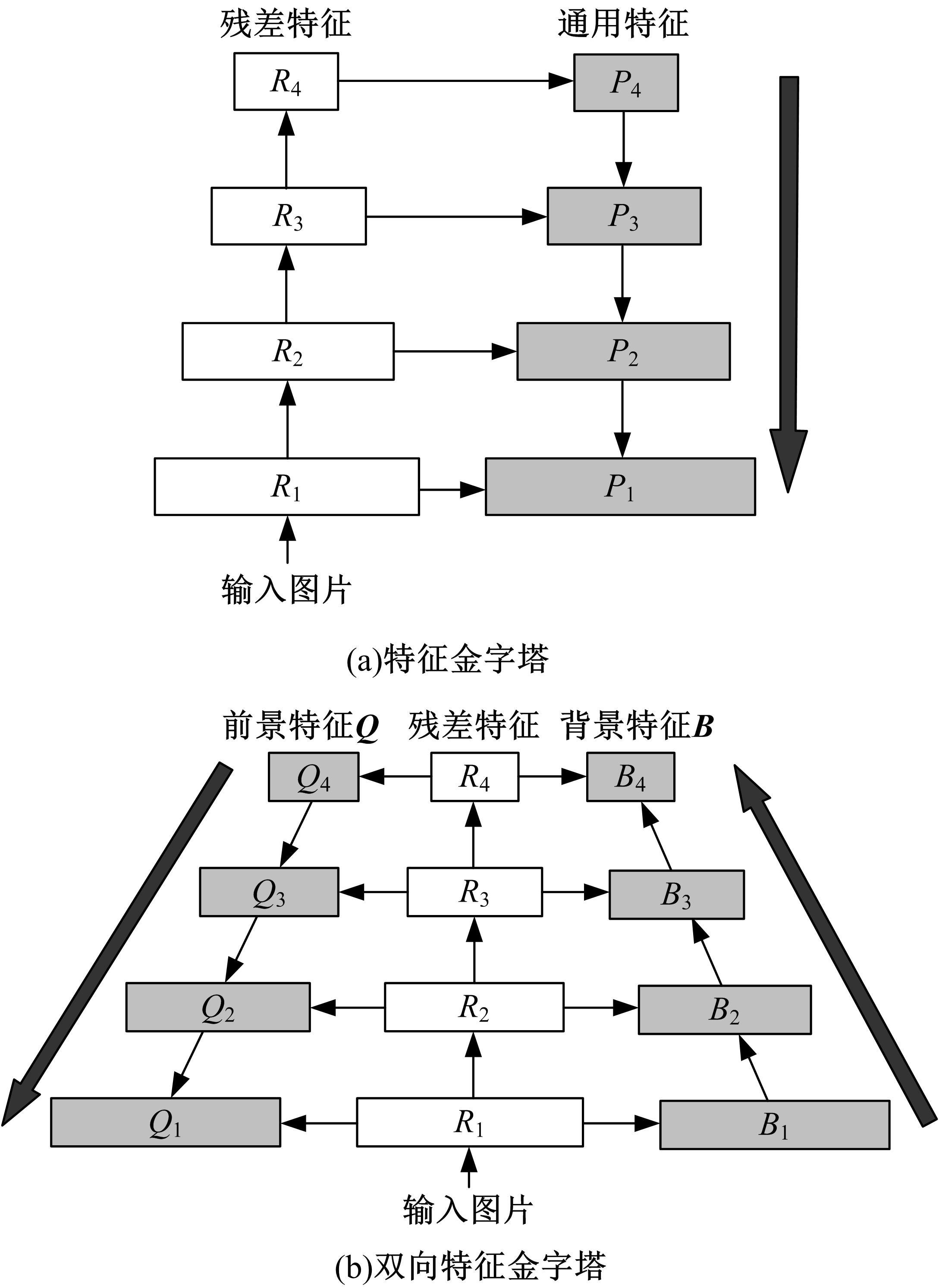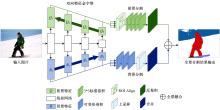Journal of Jilin University(Engineering and Technology Edition) ›› 2022, Vol. 52 ›› Issue (3): 657-665.doi: 10.13229/j.cnki.jdxbgxb20200851
Two⁃way feature pyramid network for panoptic segmentation
Lin MAO( ),Feng-zhi REN,Da-wei YANG(
),Feng-zhi REN,Da-wei YANG( ),Ru-bo ZHANG
),Ru-bo ZHANG
- School of Electromechanical Engineering,Dalian Minzu University,Dalian 116600,China
CLC Number:
- TP391.41
| 1 | Li Y, Chen X, Zhu Z, et al. Attention-guided unified network for panoptic segmentation[C]∥IEEE Conference on Computer Vision and Pattern Recognition, Long Beach, CA, USA, 2019: 7019-7028. |
| 2 | Kirillov A, Girshick R, He K, et al. Panoptic feature pyramid networks[C]∥IEEE Conference on Computer Vision and Pattern Recognition, Long Beach, CA, USA, 2019: 6392-6401. |
| 3 | Lin T, Dollár P, Girshick R, et al. Feature pyramid networks for object detection[C]∥IEEE Conference on Computer Vision and Pattern Recognition, Honolulu, HI, USA, 2017: 936-944. |
| 4 | Liu H Y, Peng C, Yu C Q, et al. An end-to-end network for panoptic segmentation[C]∥IEEE Conference on Computer Vision and Pattern Recognition, Long Beach, CA, USA, 2019: 6165-6174. |
| 5 | Xiong Y W, Liao R J, Zhao H S, et al. UPSNet: a unified panoptic segmentation network[C]∥IEEE Conference on Computer Vision and Pattern Recognition, Long Beach, CA, USA, 2019: 8810-8818. |
| 6 | Li J, Raventos A, Bhargava A, et al. Learning to fuse things and stuff[J/OL]. [2020-10-22]. |
| 7 | Badrinarayanan V, Kendall A, Cipolla R. SegNet: a deep convolutional encoder-decoder architecture for image segmentation[J]. IEEE Transactions on Pattern Analysis and Machine Intelligence, 2017, 39(12): 2481-2495. |
| 8 | 徐谦, 李颖, 王刚. 基于深度学习图像语义分割的机器人环境感知[J]. 吉林大学学报:工学版, 2019, 49(1): 248-260. |
| Xu Qian, Li Ying, Wang Gang. Robotic environment sensing based on semantic segmentation by deep learning[J]. Journal of Jilin University (Engineering and Technology Edition), 2019, 49(1): 248-260. | |
| 9 | Fan L, Kong H F, Wang W C, et al. Semantic segmentation with global encoding and dilated decoder in street scenes[J]. IEEE Access, 2018, 6: 50333-50343. |
| 10 | Ding H H, Jiang X D, Shuai B, et al. Semantic segmentation with context encoding and multi-path decoding[J]. IEEE Transactions on Image Processing, 2020, 29: 3520-3533. |
| 11 | Yang T J, Collins M D, Zhu Y, et al. DeeperLab: single-shot image parser[J/OL]. [2020-10-23]. |
| 12 | Cheng B, Collins M D, Zhu Y K, et al. Panoptic-DeepLab: a simple, strong, and fast baseline for bottom-up panoptic segmentation[J/OL]. [2020-10-23]. |
| 13 | He K M, Zhang X Y, Ren S Q, et al. Deep residual learning for image recognition[C]∥IEEE Conference on Computer Vision and Pattern Recognition, Las Vegas, Nevada, USA, 2016: 770-778. |
| 14 | 张涛, 张乐. 一种基于多尺度特征融合的目标检测算法[J]. 激光与光电子学进展, 2021, 58(2): 294-300. |
| Zhang Tao, Zhang Le. An object detection algorithm based on multi-scale feature fusion[J]. Laser & Optoelectronics Progress, 2021, 58(2): 294-300. | |
| 15 | Tian Z, Shen C H, Chen H, et al. FCOS: a simple and strong anchor-free object detector[J/OL]. [2020-10-22]. |
| 16 | 汤润发, 宋慧慧, 张开华, 等. 特征注意金字塔调制网络的视频目标分割[J]. 中国图象图形学报, 2019, 24(8): 1349-1357. |
| Tang Run-fa, Song Hui-hui, Zhang Kai-hua, et al. Video object segmentation via feature attention pyramid modulating network[J]. Journal of Image and Graphics, 2019, 24(8): 1349-1357. | |
| 17 | Yu F, Koltun V. Multi-Scale context aggregation by dilated convolutions[J/OL]. [2020-10-26]. |
| 18 | He K, Gkioxari G, Dollar P, et al. Mask R-CNN[C]∥2017 IEEE International Conference on Computer Vision, Venice, Italy, 2017: 2980-2988. |
| 19 | 潘晓英, 魏德, 赵逸喆. 基于Mask R-CNN和上下文卷积神经网络的肺结节检测[J/OL]. [2021-06-18]. |
| 20 | Dai Ji-feng, Qi Hao-zhi, Xiong Yu-wen, et al. Deformable convolutional networks[C]∥IEEE International Conference on Computer Vision, Venice, Italy, 2017: 764-773. |
| 21 | Lin T Y, Maire M, Belongie S, et al. Microsoft COCO: common objects in context[C]∥European Conference on Computer Vision, Zurich, Switzerland, 2014: 740-755. |
| 22 | Cordts M, Omran M, Ranos S, et al. The cityscapes dataset for semantic urban scene understanding[C]∥IEEE Conference on Computer Vision and Pattern Recognition Las Vegas, Nevada, USA, 2016: 3213-3223. |
| 23 | 杨丽娟, 李利. 基于双线性插值的内容感知图像缩放算法仿真[J]. 计算机仿真, 2019, 36(12): 244-248. |
| Yang Li-juan, Li Li. Simulation of content-aware image scaling algorithm based on bilinear interpolation[J]. Computer Simulation, 2019, 36(12): 244-248. | |
| 24 | Kirillov A, He K, Girshick R, et al. Panoptic segmentation[C]∥IEEE Conference on Computer Vision and Pattern Recognition, Long Beach, CA, USA, 2019: 9396-9405. |
| [1] | Xue WANG,Zhan-shan LI,Ying-da LYU. Medical image segmentation based on multi⁃scale context⁃aware and semantic adaptor [J]. Journal of Jilin University(Engineering and Technology Edition), 2022, 52(3): 640-647. |
| [2] | Ji-hong OUYANG,Ze-qi GUO,Si-guang LIU. Dual⁃branch hybrid attention decision net for diabetic retinopathy classification [J]. Journal of Jilin University(Engineering and Technology Edition), 2022, 52(3): 648-656. |
| [3] | Su-ming KANG,Ye-e ZHANG. Hadoop⁃based local timing link prediction algorithm across social networks [J]. Journal of Jilin University(Engineering and Technology Edition), 2022, 52(3): 626-632. |
| [4] | You QU,Wen-hui LI. Single-stage rotated object detection network based on anchor transformation [J]. Journal of Jilin University(Engineering and Technology Edition), 2022, 52(1): 162-173. |
| [5] | Hong-wei ZHAO,Dong-sheng HUO,Jie WANG,Xiao-ning LI. Image classification of insect pests based on saliency detection [J]. Journal of Jilin University(Engineering and Technology Edition), 2021, 51(6): 2174-2181. |
| [6] | Zhou-zhou LIU,Qian-yun ZHANG,Xin-hua MA,Han PENG. Compressed sensing signal reconstruction based on optimized discrete differential evolution algorithm [J]. Journal of Jilin University(Engineering and Technology Edition), 2021, 51(6): 2246-2252. |
| [7] | Sheng-sheng WANG,Jing-yu CHEN,Yi-nan LU. COVID⁃19 chest CT image segmentation based on federated learning and blockchain [J]. Journal of Jilin University(Engineering and Technology Edition), 2021, 51(6): 2164-2173. |
| [8] | Dong-ming SUN,Liang HU,Yong-heng XING,Feng WANG. Text fusion based internet of things service recommendation for trigger⁃action programming pattern [J]. Journal of Jilin University(Engineering and Technology Edition), 2021, 51(6): 2182-2189. |
| [9] | Jun-cong LIN,Jun LEI,Meng CHEN,Shi-hui GUO,Xing GAO,Ming-hong LIAO. Real⁃time camera planning for dynamic multiple targets considering cinematographic visual properties [J]. Journal of Jilin University(Engineering and Technology Edition), 2021, 51(6): 2154-2163. |
| [10] | Li-li REN,Zhi-jun WANG,Dong-mei YAN. Improved multi⁃verse algorithm with combined slime mould foraging behavior [J]. Journal of Jilin University(Engineering and Technology Edition), 2021, 51(6): 2190-2197. |
| [11] | Yin-di YAO,Jun-jin HE,Yang-li LI,Dang-yuan XIE,Ying LI. ET0 simulation of self⁃constructed improved whale optimized BP neural network [J]. Journal of Jilin University(Engineering and Technology Edition), 2021, 51(5): 1798-1807. |
| [12] | Hong-wei ZHAO,Zi-jian ZHANG,Jiao LI,Yuan ZHANG,Huang-shui HU,Xue-bai ZANG. Bi⁃direction segmented anti⁃collision algorithm based on query tree [J]. Journal of Jilin University(Engineering and Technology Edition), 2021, 51(5): 1830-1837. |
| [13] | Jie CAO,Xue QU,Xiao-xu LI. Few⁃shot image classification method based on sliding feature vectors [J]. Journal of Jilin University(Engineering and Technology Edition), 2021, 51(5): 1785-1791. |
| [14] | Xiao-xue SUN,Hui ZHONG,Hai-peng CHEN. Statistical analysis system for students' examination results based on decision tree classification technology [J]. Journal of Jilin University(Engineering and Technology Edition), 2021, 51(5): 1866-1872. |
| [15] | Meng-su ZHANG,Chun-tian LIU,Xi-jin LI,Yong-ping HUANG. Design of fuzzy comprehensive evaluation system for performance appraisal based on K⁃means clustering algorithm [J]. Journal of Jilin University(Engineering and Technology Edition), 2021, 51(5): 1851-1856. |
|
||











